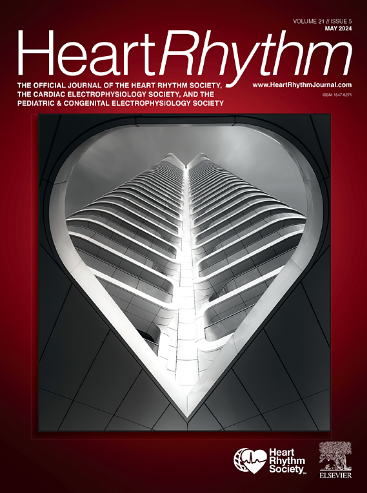无引线起搏器系统中基于温度的速率响应
IF 5.6
2区 医学
Q1 CARDIAC & CARDIOVASCULAR SYSTEMS
引用次数: 0
摘要
背景:一种新型双腔无导线起搏器(DR-LP)系统由右心室和右心房的两个植入式装置组成,使用一种不太常见的基于温度的心率反应传感器。有必要了解心室(VR-LP)和心房(AR-LP)装置在运动时的心率反应效果:确定无导联起搏器系统在运动测试期间基于温度的心率响应起搏是否与代谢工作量成正比:植入 6 周后,我们对同时参加 LEADLESS II-Phase 2(NCT04559945)和 Aveir DR i2i 研究(NCT05252702)的合格受试者实施了跑步机运动方案。在事先进行六分钟步行测试后,对程序设置进行了优化。我们分别评估了植入 VR-LP 和 DR-LP 系统的受试者的心室和心房速率响应传感器。对于每种设备,传感器指示的心率与代谢工作量的归一化斜率在所有可分析的患者中进行汇总。如果平均斜率的 95% 置信区间 (CI) 在预先规定的 0.65 和 1.35 接受范围内,则认为速率响应与代谢需求成正比:17名受试者的平均心室率反应斜率为0.93 ± 0.29(CI:0.78,1.08),符合接受标准(P = 0.001)。二十(20)名受试者的平均心房率-反应斜率为 0.91 ± 0.28(CI:0.78,1.05),也符合预先规定的标准(P=0.001):双腔无导联起搏器系统中的温度传感器能有效调节起搏频率,以应对右心室和心房设备代谢需求的增加。本文章由计算机程序翻译,如有差异,请以英文原文为准。
Temperature-based rate response in a leadless pacemaker system
Background
A new dual-chamber leadless pacemaker (DR-LP) system, composed of 2 implantable devices in the right ventricle and right atrium, uses a less common temperature-based rate-response sensor. There is a need to understand the effectiveness of the rate response during exercise in both the ventricular (VR-LP) and atrial (AR-LP) devices.
Objective
We sought to determine whether temperature-based rate-responsive pacing is proportional to metabolic workload during an exercise test in a leadless pacemaker system.
Methods
After 6 weeks of implantation, we administered a treadmill exercise protocol to eligible participants concurrently enrolled in the LEADLESS II–Phase 2 and Aveir DR i2i studies. Programmed settings were optimized after a prior 6-minute walk test. We evaluated the ventricular and atrial rate-response sensors in participants implanted with the VR-LP and DR-LP system, respectively. For each device, the normalized slopes of sensor-indicated rate vs metabolic workload were aggregated across all analyzable patients. If the mean slope’s 95% confidence interval (CI) fell within the prespecified 0.65 and 1.35 acceptance range, the rate response was considered proportional to metabolic demand.
Results
Seventeen participants had a mean ventricular rate-response slope of 0.93 ± 0.29 (CI, 0.78–1.08), which fell within the acceptance criteria (P = .001). Twenty participants had a mean atrial rate-response slope of 0.91 ± 0.28 (CI, 0.78–1.05), also falling within the prespecified criteria (P < .001).
Conclusion
The temperature-based sensor in a dual-chamber leadless pacemaker system was shown to be effective at modulating pacing rate in response to increased metabolic demand for right ventricular and atrial devices.
ClinicalTrials.gov identifier
NCT04559945 (LEADLESS II–Phase 2 study) and NCT05252702 (Aveir DR i2i study)
求助全文
通过发布文献求助,成功后即可免费获取论文全文。
去求助
来源期刊

Heart rhythm
医学-心血管系统
CiteScore
10.50
自引率
5.50%
发文量
1465
审稿时长
24 days
期刊介绍:
HeartRhythm, the official Journal of the Heart Rhythm Society and the Cardiac Electrophysiology Society, is a unique journal for fundamental discovery and clinical applicability.
HeartRhythm integrates the entire cardiac electrophysiology (EP) community from basic and clinical academic researchers, private practitioners, engineers, allied professionals, industry, and trainees, all of whom are vital and interdependent members of our EP community.
The Heart Rhythm Society is the international leader in science, education, and advocacy for cardiac arrhythmia professionals and patients, and the primary information resource on heart rhythm disorders. Its mission is to improve the care of patients by promoting research, education, and optimal health care policies and standards.
 求助内容:
求助内容: 应助结果提醒方式:
应助结果提醒方式:


